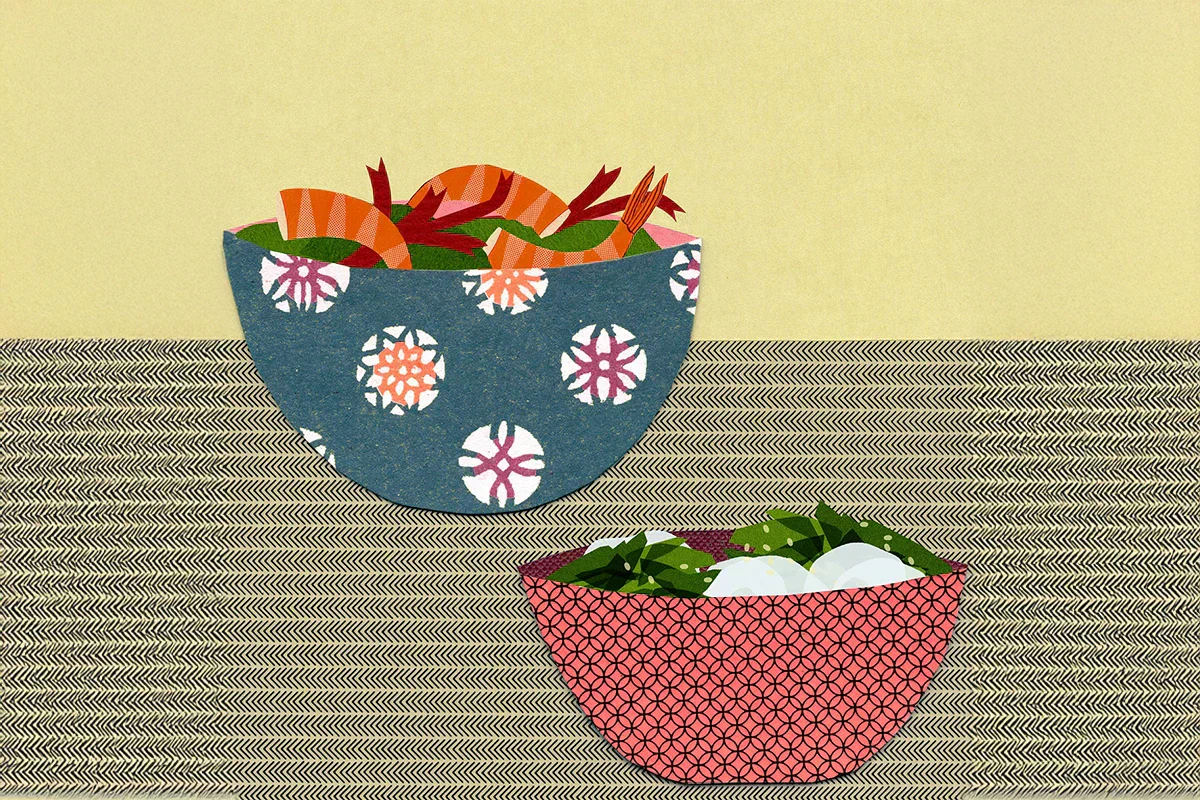
When you go to a sushi restaurant, some interesting small dishes, called koryori, arrive at the beginning of the meal, like Japanese tapas. I love to have some nibbles with a drink while thinking about which sushi to order or chatting with the chef in front of the sushi bar. The small dishes may be pickles, slow-cooked vegetables, a seafood and vegetable salad. They must be small with a light flavour, because the main reason for going to a sushi restaurant or making sushi at home is to eat the sushi.
The pleasure of koryori extends far beyond the walls of a sushi bar. They are not meant to dominate the meal, only to offer a gentle side note to it. They wake up the palate and set the scene for what is to follow. They can be as simple as a handful of blanched spinach tossed with sesame, or as intricate as a carefully balanced miso broth simmered with shellfish.
What links these little dishes is not a fixed set of recipes or method, but shared caharacteristics. They are modest in portion, never more than a few bites, and yet attentive in flavour. Each one reflects the season, perhaps a handful of young greens in spring or earthy mushrooms in autumn, and together they balance one another, offering contrast in taste and texture. A soft simmered vegetable might sit beside something crisp and vinegared, a salty note tempered by something sweet or nutty. They arrive in small bowls and plates, each dish in its own, so that even the simplest feels considered. Above all, koryori do not try to dominate the table or palate. Their role is to support, to refresh, to make space for the meal as a whole.
In my own cooking, I have found a love of this way of eating. Perhaps it has something to do with the seasons. As the days turn cooler and evenings arrive earlier, I long for things that feel modest and thoughtful rather than rich or overwhelming. A small bowl of soup, clear and steaming, or a plate of green beans dressed with sesame can feel just as restorative as a more elaborate spread. It is food that nourishes without demanding attention, and yet it leaves a mark, quietly memorable.

The recipes I want to share here are two koryori dishes, favourites of mine. One is a clam miso soup, the kind you might find in any number of Japanese kitchens or restaurants, simple but deeply comforting. The other is a dish of green beans dressed with black sesame sauce, known as goma-ae, a home-cooked favourite that is adaptable and delicious. Together they represent something essential about koryori and soup: not extravagance, but attentiveness, a sense of care that is expressed in small details.
What I like about both of these recipes is how little time they need to prep, and how complete they feel once they are on the table. The clam miso soup is simple to make, but the steps give it character. Cleaning the clams, soaking the kombu, stirring in the miso, none of it takes long, but it adds up to a very satisfying (small) dish. The broth is clean and briny, with just enough depth to be comforting without being heavy.
The green beans with black sesame are a different pleasure. Where the soup is subtle and savoury, the sesame dressing is rich and nutty, clinging to the beans with a soft, almost creamy texture. I love this sauce as it transforms whatever it touches. Green beans are classic, but I’ll also make it with blanched spinach, or with spears of asparagus in early summer. The sauce keeps beautifully, so it is worth making extra and finding other uses for it.
These dishes belong to a tradition where nothing is wasted and nothing is overdone. They are designed to accompany, not to dominate, and that makes them wonderfully flexible in a home kitchen. On a weeknight, you might make just one of them and call it enough, perhaps with a bowl of rice on the side. On a weekend, or when cooking for friends, you could prepare both and place them alongside other small dishes, a plate of quick pickled cucumbers, perhaps, or some grilled aubergine dressed with miso. There is no single way tht I can mention, about how they should be used.
In Japan, this way of eating often takes the form of Ichijū-Sansai, literally “one soup, three dishes.” It is a centuries-old framework for structuring a meal, balancing nutrition with flavour, colour and texture. Rice anchors the table, a soup provides warmth, one dish acts as a main, while two smaller sides and pickles offer variety. A little of this, a little of that, nothing overwhelming. I teach a cooking class on Ichijū-Sansai. You don’t need elaborate recipes or rare ingredients; you can shape a whole meal from whatever is seasonal and close at hand.
For those of us used to Western habits of one main course with a couple of sides, this approach can be transformative. It allows you to savour variety, but also to appreciate proportion: the pleasure is in tasting many things in modest amounts. And it helps explain why something as unassuming as a clam soup or a dish of sesame beans can feel like the heart of a meal rather than a side.

Another detail that often surprises people is the role of the bowls and plates themselves. Koryori is nearly always served in kobachi, small bowls or tiny plates known as mame-zara. At first it might look decorative, but it is more than that. The size and shape of the dishware frame the food, giving each bite-sized portion its own stage. A bright pickle in a tiny glazed bowl, a few beans gleaming against dark ceramic, a soup in a lacquered vessel that holds its warmth, these are small decisions that lift the experience of eating. Be warned though, collecting these becomes addictive!
For readers who may be trying these recipes for the first time, don’t be put off by the idea of soaking clams or crushing sesame seeds. These steps are not complicated, and they are part of the pleasure. If clams are difficult to find, you can adapt the miso soup with prawns or with cubes of tofu and wakame seaweed. If black sesame seeds are unavailable, white ones will do, though the flavour will be softer. The recipes are guides, not rules, and there easy to adapt and make your own.
Above all, take your time. These dishes are not about speed or display, but about quiet enjoyment. Make them when you feel like slowing down, when you want to prepare something thoughtful without fuss. Share them with family or friends, or make them for yourself at the end of a long day. In their modesty they hold a kind of generosity in my opinion, alongside beautiful gentle flavours, that will keep you wanting to make them.
This, I think, is what makes koryori so appealing. They remind us that food does not always have to be grand to be meaningful. A small dish, prepared with care, can be enough to shape the mood of a meal, even of an evening. It is not about filling the table, but about offering something honest, something that reflects the season and the moment. That is the beauty of these little dishes, and the reason I keep returning to them.

CLAM MISO SOUP
Some traditional Japanese people have miso soup with every meal, and a lot of restaurants serve it for free as part of the menu. You can use a variety of ingredients for miso soup, mix it with vegetables, mushrooms or shellfish, and choose your favourite dashi, or stock. It is important to use good-quality stock and miso.
Ingredients
To serve 4 as a side dish (makes approximately 900g)
- 300–350g clams
- 600ml cold water
- 5cm-long piece of dried kombu (kelp)
- 3 tablespoons of white miso paste
- 4 teaspoons of chopped chives, to garnish
Method
- Ask your fishmonger if the clams have been cleaned. If not, place them in a bowl with plenty of salted water: 1 tablespoon of salt to 500ml of water. Leave them in the fridge or a cool dark place for at least 1 hour, so that they release any sand. Rub the shells with your fingers to clean them. Throw away any that are slightly open, as these may be bad, then rinse the rest under cold running water and drain well.
- Pour 600ml of cold water into a large saucepan. Put a piece of dried kombu into the pan and leave for 30 minutes until the kombu expands and softens.
- Add the clams to the pan and start heating up on a medium heat. When it begins to boil, turn down the heat and remove and discard the kombu. Skim off any scum from the surface. By this time, the clams should be open. Discard any that aren’t.
- Scoop out some of the stock from the pan using a ladle and put into a small bowl. Add the miso paste to the bowl and stir until it dissolves. Gradually add the diluted miso to the soup, stirring gently. Remove from the heat.
- Serve in small soup bowls and garnish with chopped chives.
Tips
- Use different types of clams or shellfish, as well as different miso pastes, such as hatcho miso and awase barley miso. Experiment and see which one you like best.
- Do not overcook the soup as this will ruin the flavour.

KURO GOMA-AE
Green beans with black sesame sauce
Goma-ae is a very popular Japanese home-cooked dish. I love the aroma of the black sesame seeds and the sweet and nutty flavour of the sauce. Use a surikogi and suribachi or a regular pestle and mortar to grind the sesame seeds. I always cut the beans in half, because it is better to have bite-size pieces of food when eating with chopsticks.
Ingredients
Serves 4
- 200g green beans
- 1 tablespoon of sea salt
For the black sesame sauce
- 4 tablespoons of black sesame seeds
- 1 tablespoon of mirin
- ½ tablespoon of soy sauce
- 1 teaspoon of miso
- 1 tablespoon of brown sugar
- 1 tablespoon of water
Method
- Trim the ends off the green beans, cut the beans in half and wash them in cold water.
- Add the salt to a saucepan of water and bring to the boil. Cook the beans for 2 minutes or until tender. Do not overcook – it’s important to keep them crunchy!
- Drain the beans in a colander and rinse with cold running water to cool them down. Drain again and leave them to dry.
- To make the sauce, crush the sesame seeds in a surikogi and suribachi or pestle and mortar, grinding them into a paste.
- Gradually add the mirin, soy sauce and miso, mixing continuously.
- Add the sugar and water.
- Toss the green beans with the sauce and serve.
Tips
- Asparagus, spinach, broccoli or cauliflower all work well instead of green beans.
- The sauce keeps well in the fridge for 3 days.
This article was originally published on Japanese Food. Simply. by chef and teacher Yuki Gomi.
Yuki blends traditional and modern techniques to make Japanese cooking approachable and delicious.
Buy one of our DIY Sushi Kits and receive a voucher for 50% OFF one of Yuki’s great courses in Japanese cooking.


